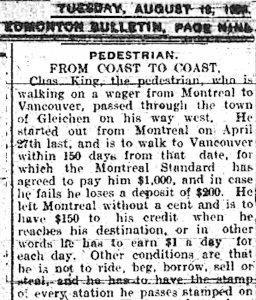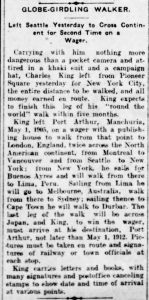Eric Zweig's Blog, page 15
September 28, 2017
A Sneak Peek…
My new book, The Toronto Maple Leafs: The Complete Oral History, will be released one month from today. Invitations to launch parties in Toronto and Owen Sound will be sent out in October. Meantime, click on this link for a sneak preview.
If you won’t be able to make either of the launches in November, you can pre-order a copy now. (The link has details.) And here’s what some advanced readers have thought of the book:
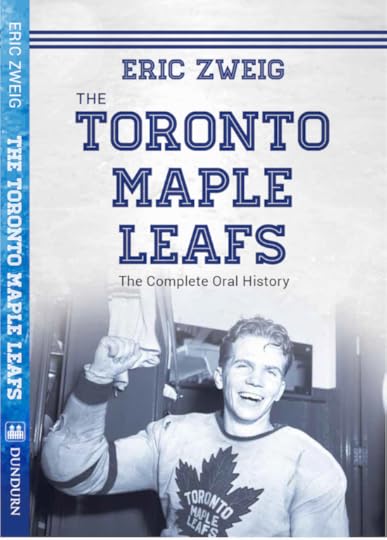
Eric Zweig captures what the Toronto Maple Leafs have meant to many hockey fans since their inception. I had particular interest in the decades following their 1967 Stanley Cup victory, and Eric captures the ups and downs of the team for all fans of hockey. I particularly enjoyed reading of the present state of the Maple Leafs and how Eric has detailed the rebirth and future of this franchise.
– Scotty Bowman, Hockey Hall of Fame Builder and winningest coach in NHL history
… I am so delighted that my distant journalistic pal, Eric Zweig, has produced this magnificent, insightful, and all-encompassing oral history of the Leafs I so much loved. To put it simply — and historically — the moment I began turning these pages, I felt precisely the same thrill as when I heard Foster Hewitt shriek He Shoots! He Scores!! on a big Don Metz goal in that classic 1942 playoff comeback. Eric Zweig wrote — and he scored!
– Stan Fischler, hockey historian, broadcaster, and author
A standout hockey book of Leaf fortunes and foibles with a twist. Zweig calls on numerous chroniclers of Leaf history to make this one hum. Leaf Nation will love it.
– Brian McFarlane, bestselling author and former broadcaster
Eric Zweig has bled blue and white since he was seven years old. But this is far, far from just a fan’s book. When you combine the abject fan with a fine historian and a writer’s ear for grand storytelling, you end up with the book on the Toronto Maple Leafs, from past grandeur through years of debacle to today’s future promise. A wonderful read.
– Roy MacGregor, bestselling author and Globe and Mail columnist
Eric Zweig is acknowledged within the hockey community as one of its premier historians, and he unequivocally proves why he has few equals in his field with this outstanding history of the Toronto Maple Leafs. Eric leaves no stone unturned with his exhaustive research in this truly entertaining but equally important book.
– Kevin Shea, hockey historian and author
Not just another history of the Toronto Maple Leafs, but generational work by one of hockey’s premier historians, period. Supremely researched and presented, as one would expect of Eric Zweig.
– Howard Berger, former Leafs radio reporter and creator of BetweenThePosts.ca
The hundred-year history of the Toronto Maple Leafs is so rich in drama and event and personality — there are even some (long-ago) Stanley Cups in there, somewhere. Trust Eric Zweig to wrangle it all into such a full and compelling narrative, which he has done — just as the Leafs look like they’re ready to dominate again.
– Stephen Smith, author of Puckstruck: Distracted, Delighted and Distressed by Canada’s Hockey Obsession
September 26, 2017
A History of Sports and The National Anthem
How is it, I was asked yesterday in the wake of recent news, that the National Anthem got hooked up with sports in the first place?
Although I had been asked specifically about hockey when I first looked into this back in 2009, the best answer I could find indicated that the practice of playing the National Anthem at sports events began when The Star-Spangled Banner was played during the 1918 World Series. That seemed reasonable to me, given that Major League Baseball cut short the regular season that year due to World War I.
However, I also found that, in a story in the Toronto Star from May 4, 1917, the National Anthem (presumably God Save the King) had been played prior to the Toronto Maple Leafs’ opening game of the International League baseball season. No doubt World War I was the reason again, but clearly, while the World Series of 1918 must have garnered more attention in the United States, it couldn’t have been the first time.
Yesterday, I asked John Thorn, the Official Historian for Major League Baseball (who I’ve known since 1998 when Dan Diamond and Associates created Total Hockey for John’s Total Sports Publishing company) what he knew about the history of the National Anthem and baseball. As it says in the sub-title of the article he sent me, the story goes “back, back, back.”
It turns out that the connection goes all the way back to the time of the U.S. Civil War. It was the opening game of the Union Grounds ballpark in Brooklyn, New York, on May 15, 1862, and the band on hand for the festivities began the musical proceedings by playing The Star-Spangled Banner. I think both John and I are only speculating at a direct connection between the War and the playing of the National Anthem that day, but it certainly makes sense.

The Brooklyn Daily Eagle, May 16, 1862. Page 2.
I wrote about God Save the King being played prior to a game in 1910 in my very first book, the novel Hockey Night in the Dominion of Canada. The book was published 25 years ago and I honestly can’t remember anymore if I’d come across any evidence of this having actually happened at the time. (The book was fiction, after all!) However, the National Anthem was most definitely played prior to the opening home game of the Ottawa Senators early in the second NHL season of 1918-19.
This game between Ottawa and the defending Stanley Cup champions from Toronto was played on December 26, 1918, just a few weeks after the signing of the Armistice that ended World War I. Prior to the War, previous Governors-General had often attended games in the Canadian capital, but with the Duke of Devonshire in attendance that night, it marked the first time since before the war that, as newspapers put it, “the hockey season was ushered in under vice-regal patronage.” When the Duke and his party arrived shortly before the start of the game, the Governor-General’s Foot Guard “played the National Anthem and every person within the big rink stood up.”

This article appeared in the Vancouver World on December 27, 1918.
But when did the National Anthem become a regular occurrence at sports event? Apparently, it wasn’t until 1924 in Paris that National Anthems were played for every winner at the Olympics. John Thorn’s story mentions that although some Major League Baseball teams had begun playing the National Anthem before games in 1941, which was prior to the U.S. entering World War II, it became universal in baseball in 1942 after American involvement. I haven’t looked into the National Anthem and football, but it seems reasonable to believe the practice started in the NFL around the same time.
As for hockey, it’s been said that the tradition of playing the National Anthem prior to games began around 1930. This picture of the Boston Bruins and Montreal Maroons at the Boston Garden may well have been taken during the NHL playoffs in 1930. It’s often said to be an early example of the “new” trend.
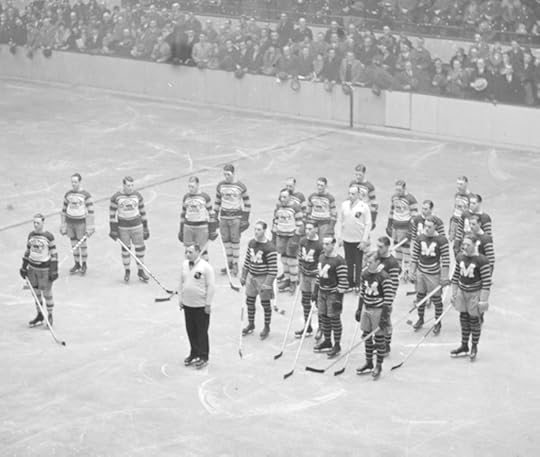
Certainly the practice seems to have been common enough that no special reason was needed when this article appeared in the Montreal Gazette on January 12, 1931:

Still, there’s reason to believe that, even if it wasn’t continuous from 1918, the link between National Anthems and the National Hockey League dates back to at least the mid 1920s, and perhaps before that. When the first NHL game was played in Madison Square Garden between the New York Americans and the Montreal Canadiens on December 15, 1925, bands played both The Star-Spangled Banner and God Save the King prior to the opening face-off.
In the PhD thesis that would become the basis of his book Joining the Clubs: The Business of the National Hockey League to 1945, my friend and colleague Andrew Ross notes that Tex Rickard and John Hammond (who ran the Garden, and soon the New York Rangers as well) “maintained the Canadian tradition of playing the national anthems before every game, not just restricting them to special occasions.” This practice, says Andrew, “continued thereafter and spread from the Garden to other cities and other sports.”
Andrew quotes Hammond from an article in the New York World-Telegram in December of 1934 as saying that The Star-Spangled Banner had been played before all hockey games at Madison Square Garden since the very first. “The Canadian anthem has always been associated with hockey there,” Hammond said, “and I think we should pay our anthem the same tribute.”
So even if baseball started it, it looks like it was hockey that made the National Anthem a regular part of going to a game.
September 20, 2017
Scotty Bowman and … the Bruins?
I don’t have a contact file filled with famous names. There are a few. Some I’ve known for a long time; others only recently. Still, it’s always exciting for me whenever I hear from any of them.
The first time I heard from Scotty Bowman was about five years ago. Phil Pritchard from the Hockey Hall of Fame emailed me to say that Mr. Bowman had pointed out an error I had made in his coaching record for my book Stanley Cup: 120 Years of Hockey Supremacy. It was basically little more than a typo, but I was horrified! Mistakes happen, but this one was pretty sloppy and, well, it was Scotty Bowman, the winningest coach in NHL history. He certainly had a reputation for being pretty tough with some pretty talented hockey players. How was he going to treat me?
I wrote a very apologetic note and got a very nice reply. That was about as far as it went, until a year or so later when I was deeply into working on Art Ross: The Hockey Legend Who Built the Bruins. I had just read a biography of Boston Bruins legend Dit Clapper by Stewart Richardson and Richard LeBlanc, which mentioned that Bowman and Clapper had been close when Bowman was starting out as a coach in Peterborough. So, I wrote again and asked Mr. Bowman if he’d ever heard any interesting stories from Dit Clapper about Art Ross.

Boston’s Bill Cowley was the childhood hero of future Canadiens coach Scotty Bowman.
That evening, Scotty called me at home. (Very exciting!) No, he said, he hadn’t heard any stories from Dit, but when he was working with Lynn Patrick for the St. Louis Blues, Patrick had told him some stories that he was happy to share. I was thrilled to be able to include them in the book. Scotty later read and enjoyed an advanced copy and provided a very nice “blurb” for the back cover. He’s done the same for my upcoming book The Toronto Maple Leafs: The Complete Oral History.
Scotty Bowman celebrated his 84th birthday earlier this week. Dave Stubbs wrote a very entertaining piece with Scotty on the NHL web site for a Q&A feature called Five Questions With… After I read it, I sent Scotty a short email wishing him a happy birthday and saying that I had enjoyed the answer he gave saying that Art Ross was the one hockey person from any era he would like to spend some time with.
Scotty told Dave Stubbs that he had been a Bruins fan as a boy. That might seem strange for a child growing up in the Montreal borough of Verdun, but at the time, the Maroons had just recently folded and the Canadiens were struggling through what was then an unprecedented 13-year Stanley Cup drought from 1931 to 1944. The Bruins were a perennial powerhouse who won the Stanley Cup in 1939 and 1941. In his reply to me – which I share with you here – Mr. Bowman provides a little more detail:
Thanks Eric. As a 6-year-old, I started listening on radio to a strong Boston station I got in my home town of Verdun. A man named Frank Ryan did play by play. I stayed up for the 1st period and my Dad left a note for me to read before School with all the results. Somehow, I had Bill Cowley as my idol. My Mom worked at Eaton’s and she got me a Bruins sweater with Cowley’s #10 for Christmas one year. With World War II breaking out, they used to say about Cowley [a star center]: “HE MADE MORE WINGS THAN BOEING.”
Regards. Scotty
September 14, 2017
It’s a Nice Idea, But…
With expectations high among Toronto hockey fans for the upcoming season, Maple Leafs president Brendan Shanahan and mayor John Tory announced this week that December 19, 2017, will be designated Toronto Maple Leaf Day. The date will mark exactly 100 years since the first games in NHL history, which were played on December 19, 1917.
“Our birthday comes on a Tuesday,” said Shanahan. (The original date in 1917 was a Wednesday.) “It’s a school night. So the decision was made [to play the game] at two in the afternoon.” It would have been nice to have had a more historically significant opponent than the Carolina Hurricanes, but what can you do? Shanahan said the Leafs are encouraging season ticket holders to bring a child with them that day, or to donate their tickets to the MLSE Foundation, which will give them to school-aged fans. Of course, the kids will have to get permission to skip an afternoon of school.
The Leafs will also be wearing special jerseys that night, modelled after the uniforms worn by the Toronto Arenas of old.

My guess would be, this jersey – which the team didn’t actually wear until the second NHL season of 1918-19 – was chosen because it so prominently displays the Arenas name. It’s pretty widely known that Toronto’s team was called the Arenas before it became the St. Patricks and the Maple Leafs … but you can pick a pretty good fight among hockey historians by asking them whether or not the Arenas name was actually used in 1917-18. The team was clearly run that first season by the owners and operators of the Arena Gardens on Mutual Street, but most newspapers referred to them that year as the Torontos, the Blue Shirts, or the Blueshirts. (Sometimes, just the Blues.) These were nicknames the team had been known as throughout the history of the National Hockey Association, forerunner of the NHL. But that’s another story for another day.
Still, if anyone had asked me, I’d have argued strongly for a sweater based on the uniform Toronto’s team actually wore during that first season of 1917-18. Yes, it’s a little bit plainer (and was pretty much the same uniform the team had worn for five seasons as the Blue Shirts/Blueshirts in the NHA), but it’s the uniform that was worn on the night of December 19, 1917. It’s the uniform Toronto players were wearing when they won the Stanley Cup at the conclusion of the first NHL season in 1918.

Harry Holmes, on the left, in the uniform of Toronto’s team
of 1917-18. Harry Cameron sports the jersey of 1918-19.
Instead of honouring the first NHL champions, the Leafs are going with a sweater that commemorates, arguably, the worst season in 100 years of Toronto’s NHL history.
The 1917-18 Stanley Cup winners completely fell apart in 1918-19. There were accusations that some team members played while drunk. That may or may not have been true, but the team was playing so poorly that the NHL decided to re-jig the entire schedule midway through just to keep Toronto in the playoff picture in a league that only featured two other teams! Even at that, the Arenas were so awful in 1918-19, and attendance in Toronto so terrible, that ownership suspended operations before the season was over. The team played just 18 games, posting an overall record of 5-13-0 for a “points” percentage of .278 that will probably always be the worst mark in franchise history. It would result in just 45 points in the current 82-game schedule. Toronto returned to the NHL in 1919-20 under new ownership comprising men who had previously run the senior amateur St. Patricks team of the Ontario Hockey Association. Hence the new name.
You can read all about those early years … and every other season in the first hundred years of Toronto’s NHL history in a certain new book due out in October…

As I mentioned a couple of weeks ago, if you’re already thinking about buying or recommending The Toronto Maple Leafs: The Complete Oral History, please consider pre-ordering a copy at Amazon or Indigo or wherever you like to buy your books. And don’t be shy about ordering any of my other books there either!
August 30, 2017
Your New Guide to the NHL Season
Though celebrations pretty much started on New Year’s Day in 2017, the NHL will officially reach its 100th birthday late this fall. The league was formed in November of 1917 in a series of meetings that culminated on November 26. The first games in NHL history were played on December 19, 1917.
The NHL Official Guide & Record Book for the 2017-18 season began shipping from the printer’s yesterday. The Guide is not quite as old as the NHL, but it does have roots dating back to the 1932-33 season when Jim Hendy published his first Hockey Guide. As I said in a similar story two years ago, Hendy worked on his Guide until 1951, after which he turned over the book to the NHL. Through expansion after 1967 and right into the 1980s, the book maintained Hendy’s original “pocket” format, although as the NHL grew from six to 21 teams it was split into two books: a Guide and a Register. In 1984, Dan Diamond proposed a reorganization and redesign that saw the NHL Official Guide & Record Book remodelled into magazine-sized pages including photographs for the first time. Dan’s first Guide was 352 pages. This year’s is a record 680 pages!

The National Bookstore cover.
When I wrote two weeks ago about the changes necessitated by new information about Chicago Blackhawks coach Godfrey Matheson, one of the comments I received noted that it was nice to see that corrections can still be made based on events from 80+ years ago. The truth is, the NHL Official Guide & Record Book is ever-evolving. A few of the records we’ve updated since last season were among the oldest in the NHL.

The NHL Media cover.
Some NHL records my last forever. No one is likely to match the 2.20 goals-per-game (44 goals in 20 games played) that Joe Malone averaged in the first NHL season of 1917-18. Punch Broadbent’s record of scoring in 16 straight games in 1921-22 seems pretty safe too in this era of low-scoring hockey. Same with most of Wayne Gretzky’s records from the 1980s and ’90s. Even so, it’ll take some doing to match the 22 shutouts George Hainsworth posted in 1928-29 – especially considering that Hainsworth did it in a 44-game season! Tough to beat his 0.92 goals-against average too.

The New York Rangers custom cover.
Still, Auston Matthews’ four-goal game in his NHL debut in October of 2016 has found its way into the NHL Guide & Record Book for this season – although Matthews only holds down second spot for the most goals by a player in his first NHL game … behind Joe Malone and Harry Hyland, who scored five goals on the first night in NHL history. Adding Matthews also allowed us to correct a 100-year oversight by including the name of Reg Noble on the list of four-goals debuts. He also accomplished his feat on the first night in NHL history.
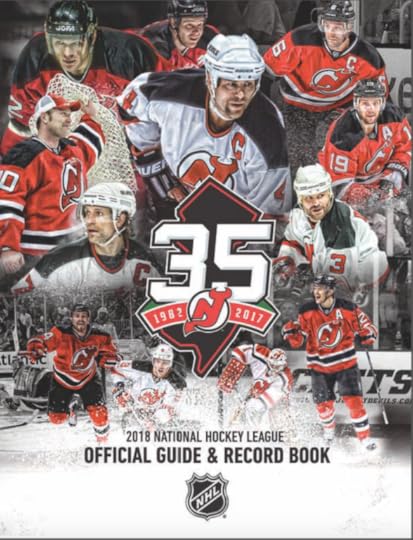
New Jersey Devils custom cover.
Corey Perry of the Anaheim Ducks matched a pretty long-ago feat during the playoffs this past spring. While not quite as dramatic as the three overtime goals scored by Mel Hill in a single series for the Boston Bruins against the New York Rangers (including a game seven series winner) in 1939, Perry did join Hill and Maurice Richard (who did it over two series in 1951) as the only players in NHL history to score three overtime goals in one playoff year. Perry got one in the first round versus Calgary, a second in the second round versus Edmonton, and his third in the Western Conference Finals against Nashville.

Calgary Flames custom cover.
As Dan Diamond writes in his introduction this year, the 2018 Guide & Record Book will also reflect a recent and welcome decision by the NHL to apply today’s standard to earlier years by identifying certain players who played the majority of the regular-season for teams that would go on to win the Stanley Cup. Previously, for various reasons, these players were not considered to be official Cup winners. This has changed. The following six players have now been added to their club’s list of Stanley Cup-winners: Vic Stasiuk (Detroit 1954), Jackie Leclair (Montreal 1957), Kent Douglas (Toronto 1964), John Brenneman (Toronto 1967) and Don Awrey and John Van Boxmeer (Montreal 1976).
The NHL Official Guide & Record Book will begin showing up in bookstores in September. If you’re a media person who receives The Guide from the NHL, or from Dan Diamond & Associates directly, you should be getting your copy soon. If you’re a customer who prefers to purchase it directly from our office, it’s time to send in your email order or click this link to the dda.nhl eBay site.
August 23, 2017
Book Business…
As I mentioned a couple of weeks ago, in addition to my usual busy summer working on the NHL Official Guide & Record Book (more on that next week), I’ve been working on a lot of books of my own recently. The biggest one in terms of size, time, and – hopefully! – impact is my new book for Dundurn, The Toronto Maple Leafs: The Complete Oral History.
Some of you reading this will already know about this book. Some will also have seen the original cover. But just last week, my editor, Allison Hirst, sent me the new cover. Here it is:

The original cover was somewhat similar, but had just a generic image of a hockey stick and puck. I never loved it, but it was certainly hard to think about which one player should be on the cover. A picture of Maple Leaf Gardens struck me as a possibility, but that’s hardly the most dynamic image. This redesign happened without any input from me, but I’m very pleased with it. It’s hard not to like a smiling Bill Barilko!
It was 66 years ago this week, on Friday, August 24, 1951, that Bill Barilko and Dr. Henry Hudson took off on their ill-fated fishing trip. Two days later, on Sunday, August 26, they crashed while returning to their hometown of Timmins, Ontario. A few months earlier, Barilko had scored the Stanley Cup-winning goal against the Montreal Canadiens in overtime. The Leafs would not win the Stanley Cup again until 1962. A few weeks after that, the wreckage of Barilko’s long-lost plane was finally found. If it wasn’t a true story, it would have been too unbelievable for someone to make up.
Bill Barilko was only 24 years old when he died. He’d played just five seasons with the Maple Leafs, but had helped them win the Stanley Cup four times. Many of his former teammates would later say that Barilko had the makings of a perennial all-star or even a future Hall of Famer. He was certainly one of the hardest hitters in the NHL in his day, but despite scoring one of the most famous goals in hockey history, he was a defensive defenseman. Not a lot of those guys get the glory.
It’s impossible to know what would have become of Bill Barilko if he’d never taken that fishing trip. The truth is, when I was researching the 1951 Cup Final for my book, I came across a couple of indications that the Leafs may actually have been thinking about trading Barilko … or at least that the Canadiens might have been considering trading for him:

Globe and Mail, Toronto, April 23, 1951. Page 21.

Toronto Daily Star, April 24, 1951. Page 18.
I don’t actually get into those rumors in my book, but I think that even if you know the history of the Maple Leafs up and down and backwards and forwards, you’ll still find plenty of stories you don’t know. I’m really thrilled with how it’s all come together. It was more like editing a huge documentary film than writing a book. I’ll be posting an even more obvious “commercial” for it in the next few weeks.
In the meantime, the publicists at Dundurn tell me it’s becoming increasingly important these days for books to get a good spike of online pre-order sales before they’re released. Pre-orders signal to bookstores that they need to stock up on the title. This can make a huge difference to overall sales. So if you had already been thinking about recommending or buying The Toronto Maple Leafs: The Complete Oral History, please consider pre-ordering a copy at Amazon or Indigo or wherever you like to buy your books. Oh, and don’t be shy about ordering any of my other books through these links either!
August 17, 2017
Good Godfrey!
The NHL Official Guide & Record Book for the upcoming season was sent to the printer’s earlier this week. More on that in an upcoming post. For now, a story about my quirkiest contribution to this year’s Guide…
Godfrey Matheson is a name known only to hardcore fans of hockey obscurities. He was, very briefly, one of many coaches in the early history of the Chicago Blackhawks (then spelled Black Hawks). If you know the stories about him (and some of you will), you’re likely to know some variation of these:
Matheson was from Winnipeg, home of Chicago’s star goaltender Charlie Gardiner.
Matheson had little or no coaching experience when he was hired by Blackhawks owner Frederic McLaughlin after a chance meeting on a train.
Matheson’s main claim to coaching fame was leading a Winnipeg high school team to a juvenile championship.
Matheson devised a system of coaching the Blackhawks by whistle, which he would use to signal his players from behind the bench. One blast instructed the puck-carrier to pass; two toots meant shoot; three signalled a switch in defensive formation.
Strange as it sounds, most of these stories appear to be be true … except that Matheson never actually coached a regular-season game in his NHL career!
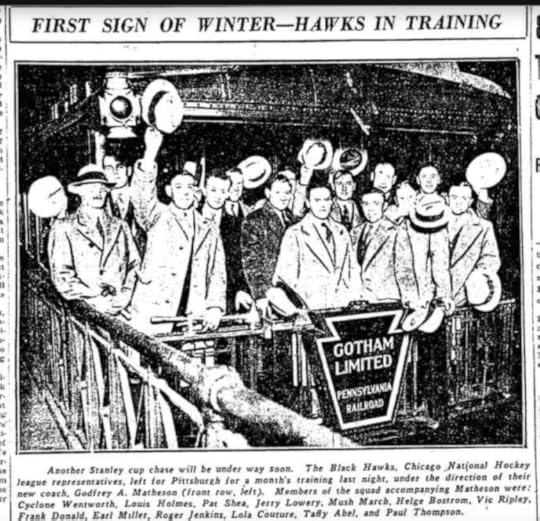
This picture appeared in the Chicago Tribune on October 15, 1931 with the story announcing the hiring of Godfrey Matheson. He appears at the far left, with the hat low over his eyes.
For decades, NHL records have shown Godfrey Matheson coaching the Blackhawks midway through the 1932-33 season. He was thought to have held down the job for just two games between the brief tenures of Emil Iverson and Tommy Gorman. In fact, Matheson was actually hired in October of 1931, but by the time the season started on November 12, 1931 – with Chicago visiting Toronto for the opening of the brand new Maple Leaf Gardens – he was no longer with the team.
Frederic McLaughlin had a penchant for firing his hockey coaches in a way that makes the late George Steinbrenner’s treatment of his baseball managers seem almost tame by comparison. McLaughlin was married to Irene Castle, a jazz-era dance, film and fashion icon who was played by Ginger Rogers opposite Fred Astaire in the 1939 film The Story of Vernon and Irene Castle. Irene wrote a serialized newspaper biography that appeared in the Chicago Tribune late in 1958. She paints a rather unflattering picture of McLaughlin.
“The early 1930s were not good years for me,” writes Castle, “but not for the same reason they were bad for the country. My trouble was not money. Instead, it was the slow decline of a marriage which had not been too satisfactory even in its early stages. Frederic became interested in a hockey team, which kept him in a temper much of the time.”
Castle describes McLaughlin as running his team “with the zeal of an amateur who doesn’t know what it’s all about.”
“I often wished he had never seen a hockey stick,” she says. “He was always getting mad at somebody.… His favorite sport was quarrelling with [coaches].”

Stories from the Chicago Tribune on September 6, 1931,
and the Globe in Toronto on September 7.
Dick Irvin, for example, had been the first star player in Chicago, and coached the team after a fractured skull ended his playing career. Irvin coached Chicago to the Stanley Cup Final in the spring of 1931, but that wasn’t enough to keep him employed and he became the seventh coach to lose his job in the five-year history of the team.
Some records show Irvin beginning the 1931-32 season as the coach in Chicago before moving on to join the Maple Leafs in Toronto five games into the schedule. The truth is he was fired or quit on September 5, 1931, six weeks before the Blackhawks began training camp. Irvin offered little about the reason for his departure in newspapers over the next couple of days, but it was later reported by Globe sports editor Michael J. Rodden that Irvin had not been in agreement with training methods favoured by Chicago management. Enter Godfrey Matheson, who was hired by the Blackhawks on October 14, 1931.
Stories at the time make no direct mention of McLaughlin and Matheson meeting on a train, but do state his brief success as a coach at St. John’s College in Winnipeg. Stories in the Winnipeg Tribune on October 24 and 28 discuss his having played earlier at the same school, and later with the Winnipeg Victorias team in the Winnipeg city league and with a local Bank of Commerce hockey team.

This photo appeared in the Chicago Tribune on October 23, 1931.
The Blackhawks and their new coach left Chicago for training camp in Pittsburgh on the evening of October 14. They would work out on the ice at Duquesne Garden, in the gymnasium at the Young Men’s Hebrew Association, and engage in outdoor runs when the weather permitted. It would be years before stories of Matheson’s whistle system appeared in newspapers, along with tales of him training his goaltenders by have as many as three or four pucks at a time thrown at them (not shot) from all angles. Even so, Toronto Star sports editor Lou Marsh, writing on the eve of the new season on November 11, 1931, hinted at the unusual tactics and described Matheson’s odd attire at training camp: “He wore skates and knee pads – and had his garters on the outside of his knee pants… He looked like he was going to lay a cement sidewalk.”
But by then, Matheson was no longer with the Blackhawks. The Chicago Tribune reported on November 10, 1931, that the coach had entered a Pittsburgh hospital the day before with a stomach ailment. The Toronto Telegram had a very different story when the Blackhawks arrived to face the Maple Leafs without their coach: “Godfrey Matheson … has departed to Florida, a victim of a nervous breakdown.”
The Telegram believed that Matheson may have jumped the team before he was pushed, but a story in the Winnipeg Free Press on December 3, 1931, would note that Matheson was spending the winter in Daytona Beach after being ordered by doctors “to take a long rest.” His health was reported as improving, “but he will be unable to rejoin the team this season.”
And he never did. So, in consultation with the Blackhawks (they had a few other things wrong; so did we) and the NHL’s long-time statistician Benny Ercolani, here is the new Chicago Coaching History that will appear in the NHL Guide beginning this season:
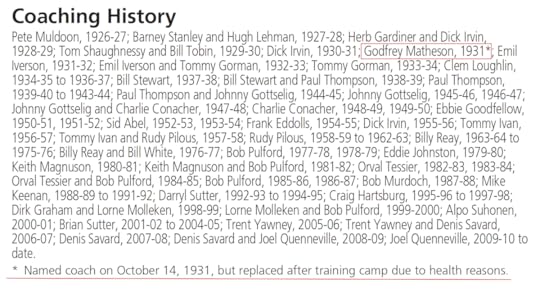
There are also a few corresponding changes to coach’s Win-Loss records in the early years.
August 10, 2017
Fit For a King…
I haven’t posted anything since June 27. Have you missed me?
I hadn’t meant to take all this time off. I’ve just been very busy. Since May, we’ve been back at work on the NHL Official Guide & Record Book, which is scheduled to head to the printer around the middle of next week. In addition, since about this time last summer, I’ve been working on 11 different book projects for five different publishers. Only one has come out so far. The others have, in some form or another, kept me busy all summer. A couple of them still aren’t done. (One of my brothers is always commenting that “I must be rich.” Sadly, all I am is busy!)
It seems the combination of too much work and too little fun following the Blue Jays has meant not enough time for stories on my web site. Tonight (although in reality two nights ago by the time I post this) has actually been the first time all summer that I’ve had a story pop into my mind that I couldn’t shake. So I wrote it down.
This has been a story I’ve been thinking about since June 20 … 2005! At that point, we were nearing the end of the NHL lockout that wiped out the entire 2004-05 season. It was really becoming possible to search newspaper archives on line, and I had been collecting stories on the early history of the Stanley Cup, which would eventually lead to a 2012 book. While doing that, I came across this story in the Edmonton Bulletin from August 18, 1908:
The story goes on to mention that Charles King carried with him a letter from Thomas Shaughnessy, president of the Canadian Pacific Railway, allowing him to walk across the country along the CPR tracks. He carried another letter from the Royal North West Mounted Police stating that he was “not to be molested.”
Something about this really spoke to me. I thought there might be a book in it too. So, within days of coming across the story, I had written to the Canadian Pacific archives in Montreal asking if they had any information on the Shaughnessy letter. They did not. (It’s been a few years since I last followed up, but archivist Jo-anne Colby promised to keep an eye out for anything for me.) An email to the RCMP Heritage Center in Regina also turned up nothing. I later searched through six months of issues of the Montreal Standard on microfilm, figuring that if the newspaper had a stake in this story they would be hyping it all summer long to try and boost their circulation. I found not one word…
Over the next year, I did come across a handful more stories of Charles King, mostly in newspapers in Western Canada, tracking his progress across the country. Some mentioned that King had developed his theories of nutrition and exercise at the Stymana club in Montreal … but I could never find any record of such an establishment existing.

Japanese print displaying the destruction of a Russian ship at Port Arthur,
Manchuria. This image will make more sense if you keep on reading!
Several newspaper all across North America reported that King reached Vancouver on September 14, 1908 — day 137 of his 150-day trek. According to some, he had only earned $120 of the $150 he needed, but he still had 13 days to earn the additional $30. Over the years, I’ve collected stories of his arrival in Vancouver from 11 different newspapers … but I’ve yet to find a single one that followed up to report on whether or not he ever made the money he needed to win the bet. (Eventually, a story in the Vancouver World from Bellingham, Washington, on October 21, 1908, noted that “Charles King, who has just completed a walking trip from Montreal to Vancouver, B.C., winning a wager of $1000, arrived in the town of Nooksack yesterday and has proceeded on his way to Seattle…” so I guess he did earn those extra $30.)
Based on the stories I’d collected, I assumed Charles King must be from Montreal (I’d later find other stories indicating he was actually from Detroit) and that this was a Canadian saga. But more recently, I’ve learned that King’s was a much bigger story. In April of 2015, I found stories in four different newspapers saying that he had left Seattle in March of 1909 to walk to New York … and that this dual crossing of North America was actually part of a bet that began on May 1, 1905 in Port Arthur, Manchuria, in which King had wagered that he could walk around the world within seven years.
I would later come across stories claiming that Charles Addington King was a former war correspondent who had covered the Spanish-American War (1898), the Boer War (1899-1902) and the Russo-Japanese War (1904-1905). Some stories claim that the bet he apparently made with publishing interests in London, England, was for $12,000 in gold.
In stories from the summer of 1909, as King was leaving St. Paul, Minnesota for Chicago en route to New York, he told reporters: “I am now seven months ahead of my schedule, or in other words, I am 5,000 miles to the good.” But I have yet to discover if Charles King made it back to Port Arthur by May 1, 1912. I’ve never even found any stories about him beyond that summer of 1909.
June 27, 2017
Hockey Awards Season
The Hockey Hall of Fame announced its class of 2017 yesterday. Five players and two builders. I don’t know a lot about University of Alberta legend Clare Drake, but someone who dedicated his life to teaching and coaching seems to me to be the type of person the category of builder was created for. Jeremy Jacobs has certainly done his share for the game, but rich guys who own teams are a little bit harder for me to get behind.
As for the players, it’s a pretty media-friendly group this year. And you can’t really argue with the numbers for guys like Dave Andreychuk, Mark Recchi, and Teemu Selanne – although of those three, only Selanne ever achieved real superstar status. Danielle Goyette is definitely a worthy recipient from women’s hockey. Paul Kariya? Well, who doesn’t like Paul Kariya? His totals of 402 goals and 587 assists for 989 points in 989 games are pretty impressive, and at his best, he was also a superstar. Still, he’s a lot like Eric Lindros, Pavel Bure and Peter Forsberg in that he’s yet another inductee of whom it could be argued that he’s being honoured for the potential of what might have been if not for the injuries …. But I’m not really going to complain.

The Hockey Hall of Fame doesn’t release voting results the way the Baseball Hall of Fame does. (Hockey has a fairly small selection committee of industry insiders, while Baseball relies on a large pool of veteran sportswriters.) The NHL does reveal the details of the voting for its awards, but since I’m not aware of a lot of media outlets that ever bother to release them, I thought people might find it interesting to see the results. So, here they are…
 Selected from 167 votes cast by the Professional Hockey Writers Association.
Selected from 167 votes cast by the Professional Hockey Writers Association.

Selected from 167 votes cast by the Professional Hockey Writers Association.

Selected from 167 votes cast by the Professional Hockey Writers Association.

Selected from 30 votes cast by NHL general managers.

Selected from 167 votes cast by the Professional Hockey Writers Association.
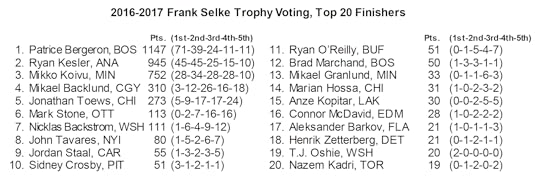
Selected from 167 votes cast by the Professional Hockey Writers Association.

Selected from 105 votes cast by the NHL Broadcasters Association.

Voting conducted among NHL general managers and a panel of NHL executives, print and broadcast media at the conclusion of the second round of the Stanley Cup playoffs.
June 14, 2017
Back-to-Back Wins for The Penguins
I’ve been trying over the last couple of days to come up with a unique historical angle on this year’s Stanley Cup Final. Yes, it’s certainly impressive that the Pittsburgh Penguins have become the first team since 1997 and 1998 to win back-to-back titles, which makes them the first to do so during the current Salary Cap Era. Still, I’m not sure if “the first since…” truly constitutes making history.
I haven’t really come up with anything, but here are some quick items of interest I’ve read or heard since the Finals wrapped up with Pittsburgh’s 2-0 win over Nashville on Sunday night (with a few more historical insights added):
– Not only do the Penguins join the Edmonton Oilers as the only non-“Original Six” NHL team to have won the Cup as many as five times, they’re the first team ever to win their first five Cup titles against five different teams.
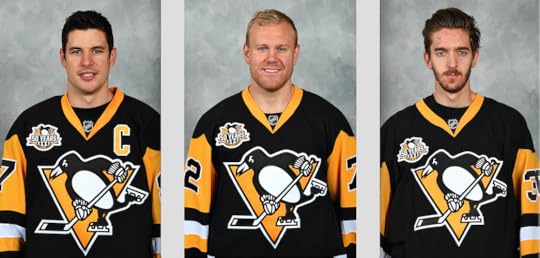
Pittsburgh Stanley Cup heroes Sidney Crosby, Patric Hornqvist and Matt Murray.
– No team in NHL history has played more games in two consecutive playoff years than the 49 the Penguins have played the last two years (24 last year, 25 this year). As an interesting comparison, the first team ever to play 25 games in one year (regular season AND playoffs combined) en route to winning the Stanley Cup was the Toronto Blueshirts of 1913-14. Toronto went 13-7-0 during the regular season in the National Hockey Association, won a two-game playoff with the Montreal Canadiens and then swept a best-of-three Stanley Cup series from the Victoria Aristocrats. When the Ottawa “Silver Seven” held the Stanley Cup for nearly four straight seasons from 1903 to 1906, they barely topped 49 games in total that entire time, playing just 30 regular-season games plus another 23 in Stanley Cup challenge matches. The Ottawa Senators of 1926–27 were the first team in history to play as many as 50 games in one season en route to winning the Stanley Cup, going 30-10-4 during the 44-game regular season and then playing six more games in the two rounds they needed to get through the playoffs.
– Although the Cup has been decided in overtime 17 times in NHL history (18 all-time if you count Dan Bain’s overtime winner for the Winnipeg Victorias in 1901), Patric Hornqvist became just the third player in NHL history to score the Cup-winning goal in the final two minutes of regulation time. The others: Boston’s Bill Carson in 1929 (18:02 of Game 2 at NYR) and Chicago’s Dave Bolland in 2013 (19:01 of Game 6 at BOS). Ernie McLea scored the Stanley-Cup winning goal with about two minutes remaining when the Montreal Victorias beat the Winnipeg Victorias 6-5 to win their one-game, winner-take-all Stanley Cup rematch all the way back in 1896.
– Matt Murray is the first goalie in NHL history to win the Stanley Cup-clinching game in each of his first two seasons in the league. (Rollie Melanson won the Cup his first three years in the NHL with the New York Islanders in 1981, 1982 and 1983, but saw almost no action during the playoffs as the back-up to Billy Smith.)
– Murray is also just the fourth goalie in NHL history to post two consecutive shutouts in the last two games of the Stanley Cup Final. The first three all played for Detroit: Earl Robertson in 1937, Johnny Mowers in 1943, and Terry Sawchuk in 1952. Incidentally, I had a quirky little story including Earl Robertson that I posted during those weeks when I seemed to be having email issues. If you never saw it, please click here.

